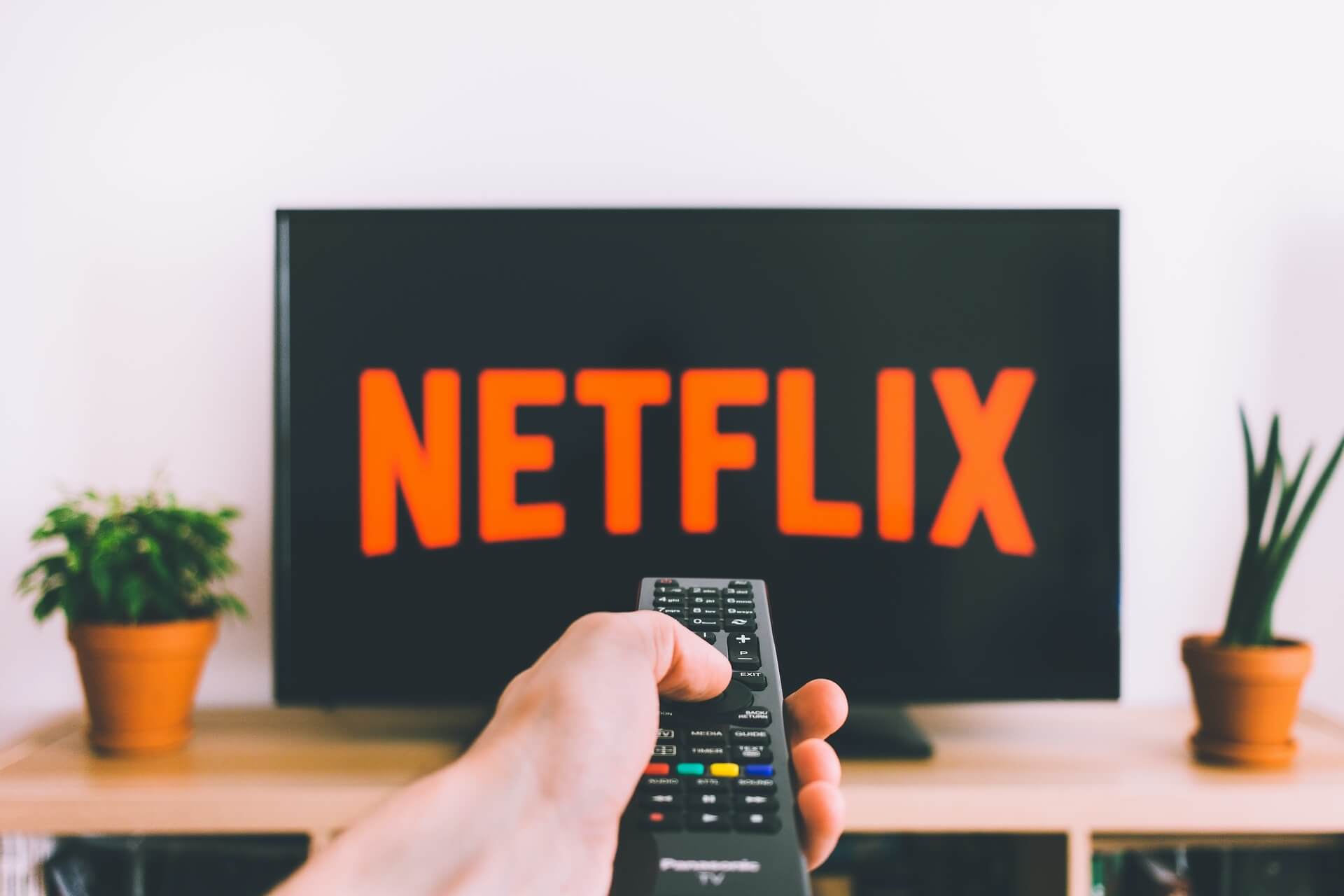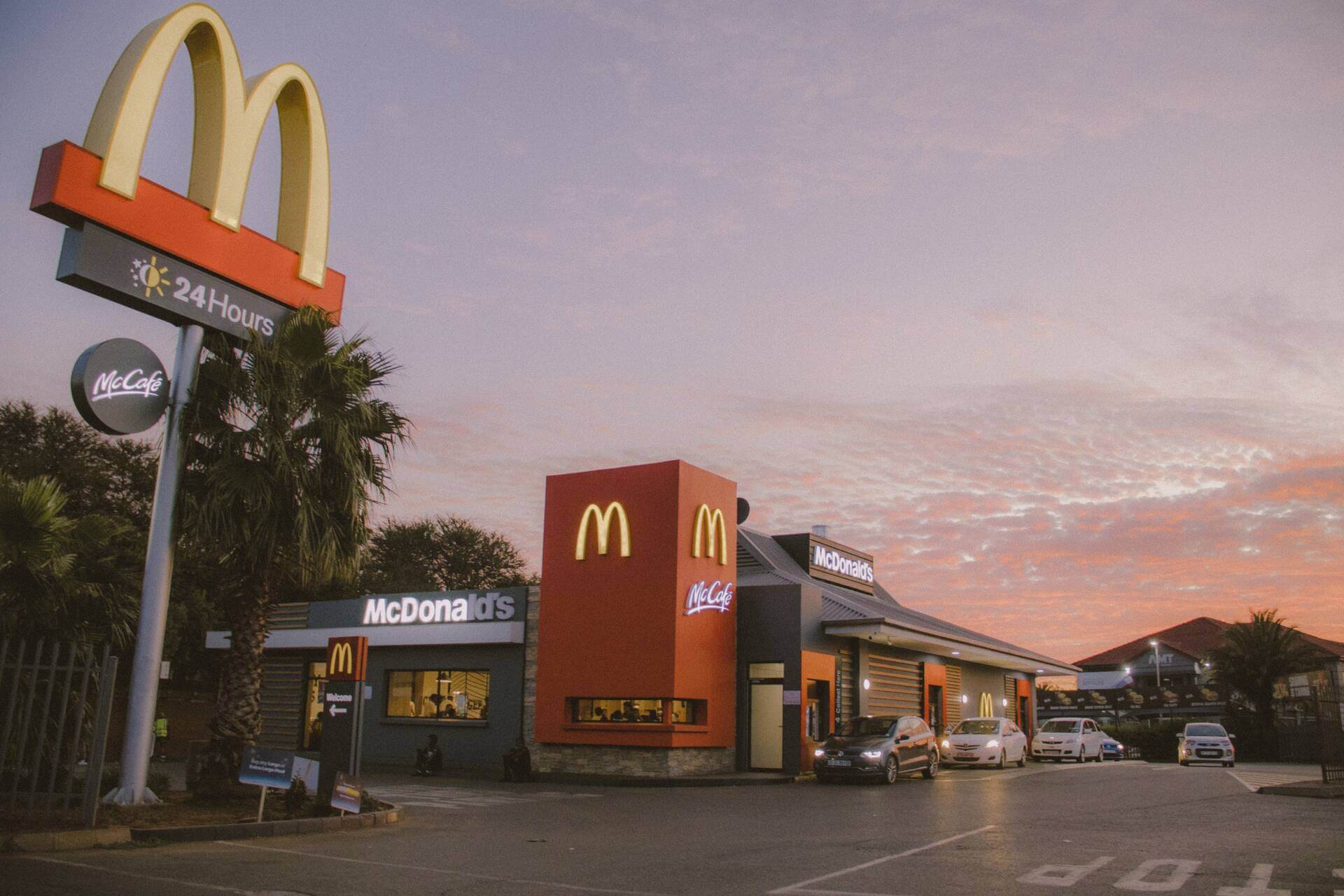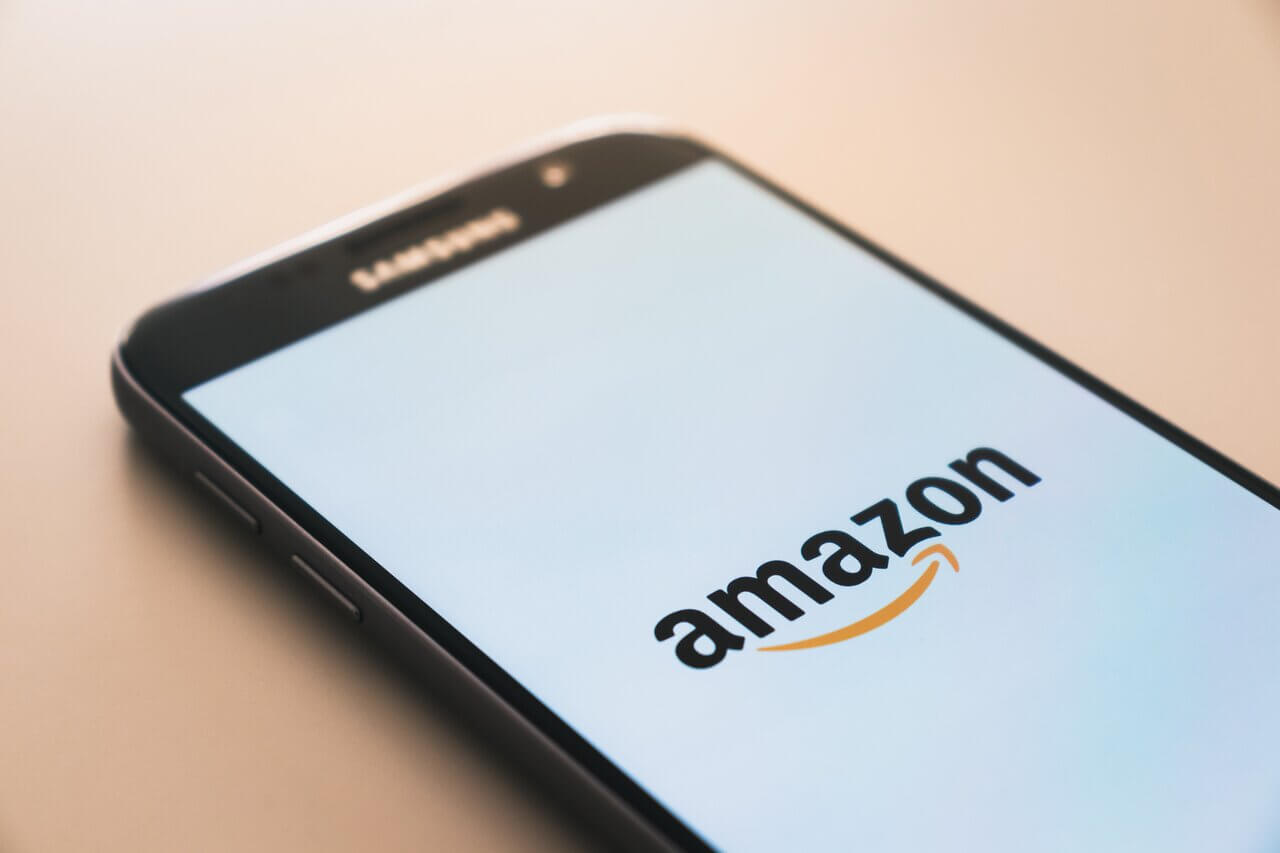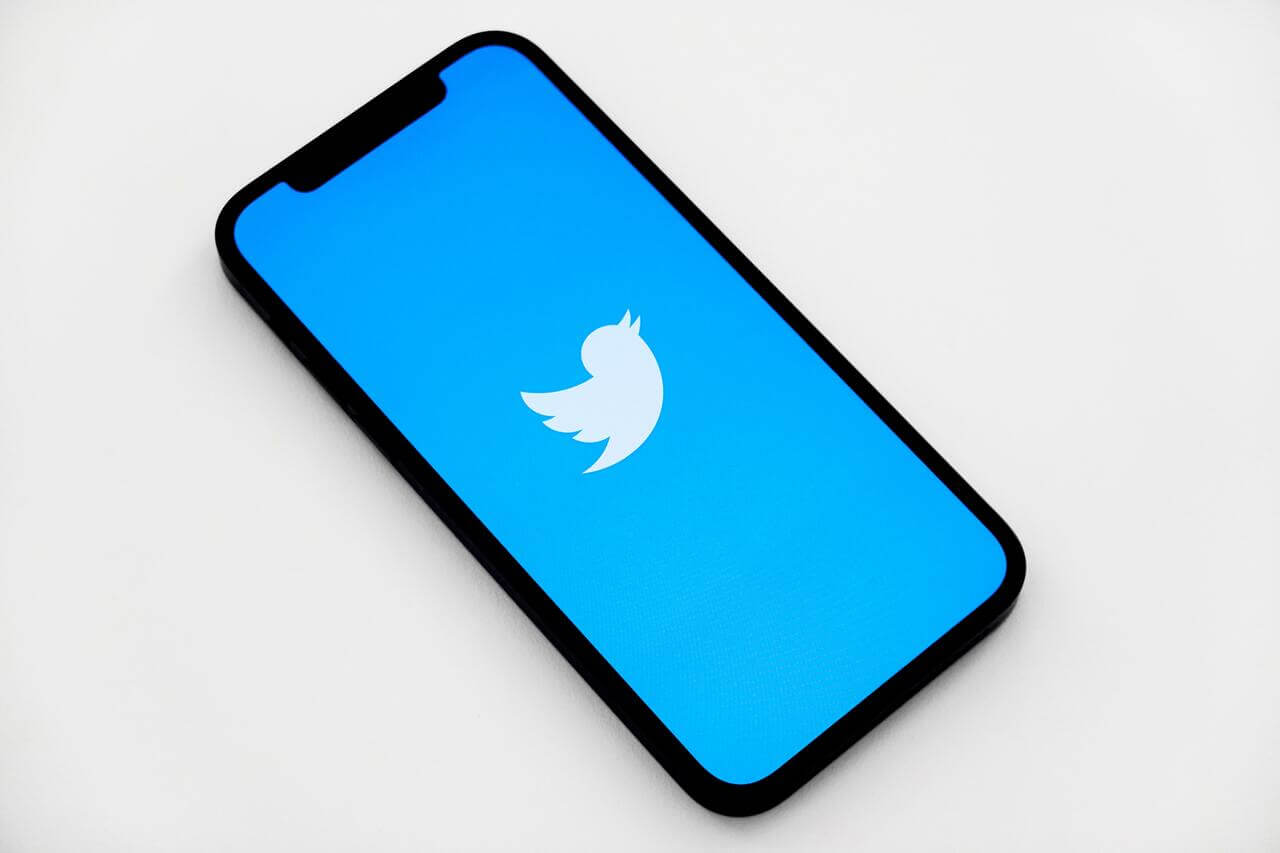The fast-food industry has been intensely competitive from the very beginning. Despite this, Burger King has created a strong brand position due to its clever growth strategies.
Burger King is the second-largest hamburger chain in the United States after McDonald’s. It receives at least 11 million daily customers with revenues as high as $20 billion at the end of 2020. As of October 2021, Burger King has 18,700 restaurants in 100 different countries. It’s safe to say that it is one of the biggest fast-food chains in the world today.
But ever wondered how Burger King came up with the juicy whopper burger? Or maybe you’re curious about the McDonald vs. Burger King beef and how it impacted the growth of Burger King? We’re going to give you an in-depth look at the humble beginnings of this company and how it turned selling burgers and fries into a profitable business model worth billions of dollars.
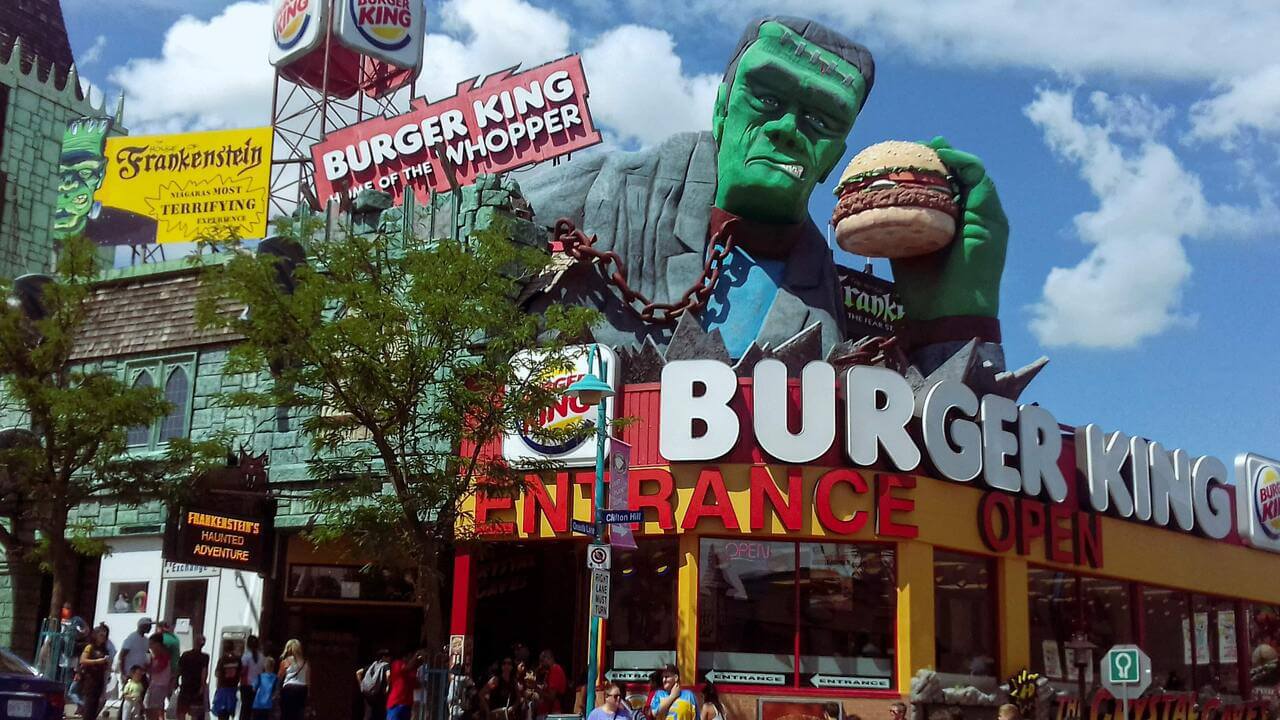
1953-1960: Burger King’s Humble Beginnings
1953: Riding the Fast-Food Wave
The year is 1953 in Jacksonville, Florida. Keith Kramer and his wife’s uncle, Matthew Burns, were inspired by the success of the McDonald’s franchises over in California. McDonald’s had been operating their drive-by burger restaurant for about 5 years at this point.
Kramer and Burns realized that there was a demand for convenience from the 1950’s customer. People were looking for quick service, affordability, and convenience from the food industry. The postwar baby boom families wanted to feed their families good, hearty meals without spending hours in the kitchen.
Several appliances were revolutionized and designed to reflect this demand, as was food technology. For example, frozen foods, including fruits, vegetables, and TV dinners, quickly became household staples.
Fast food was also a great idea business-wise. The food could be easily replicated and franchised, allowing rapid growth and quick profitability with minimal investment.
It was against this background that Kramer and Burns began searching for a business concept similar to what McDonald’s was doing. They landed on purchasing the rights to a particular grill machine called the Insta-Broiler. The device cooked burger patties in a wire between two broilers, ensuring that the parties were cooked on both sides simultaneously. The Insta-Broiler could cook over 400 patties an hour.
The pair named their restaurant Insta-Burger King and began selling hamburgers as their main product. The menu consisted of French fries, soft drinks, milkshakes, and desserts.
The restaurant gained popularity and caught the notice of two friends James McLamore and David R. Edgerton. They were seeking an opportunity to open their own business.
1954: The Beginning of the Insta-Burger King Franchise
McLamore had visited the first hamburger stand belonging to the McDonald brothers in San Bernardino, California, a few years back. He saw potential in their innovative assembly line-based production system and set his sights on opening a similar operation. McLamore had a background in the foodservice industry as he was the owner of an establishment called Brickell Bridge Restaurant.
Edgerton was also in the foodservice industry, having operated a pie-making business at University and as a restaurant manager for the Howard Johnson hotel chain. He was toying with the idea of leaving his job and opening a Dairy Queen with a hamburger section in Jacksonville.
However, when McLamore told him about Insta-Burger, he changed his mind. The two friends noticed that the growth of the Miami metropolitan area made for an excellent fast-food location. Their business model was to start a restaurant with a limited menu, low prices, and fast services.
Unlike McDonald’s drive-by model or the standard carhop service popular in other fast-food restaurants like Church’s Fried Chicken and KFC, they wanted their customers to go inside the restaurant, place orders, and pay in advance. This approach would give them an edge becoming the first chain to offer dining rooms.
Edgerton sold his Dairy Queen franchise and used the proceeds to come up with his share of the money for the Insta-Burger King Miami franchise in March 1954.
Issues with the Insta-Broiler Machine
The business was well underway. Edgerton had estimated that profits would be as high as 28%. However, some issues arose when the Insta-Broiler machine malfunctioned due to the metal parts grinding against each other. The machine’s heating elements were prone to degradation from the drippings of the beef patties.
Fed up with how frequent the breakdowns were occurring, Edgerton grabbed a hatchet and sank it into the stainless steel mechanism destroying it. For the next three weeks, Edgerton worked with a local mechanic to improve the Insta-Broiler machine.
They came up with a continuous chain broiler that ran on gas and called it the flame broiler. The mechanized gas grill avoided problems by cooking the meat patties a different way inside the unit.
1955-1959: The Birth of Burger King
Expansion of Insta-Burger King
Just two years after opening the first Insta-Burger King restaurant in Jacksonville, the business had opened forty different locations throughout Florida. Two essential things contributed to the success of the franchise.
The first was the introduction of the Burger King mascot in 1955, which became the face of the company’s TV and print advertising campaigns. The adverts drew in thousands of customers all over the state. The next was the launch of the Burger King Whopper burger in 1957.
1957: The Whopper Makes a Debut
Despite the successful launch of new locations all over the state, things were not looking good financially, especially for Edgerton and McLamore’s franchise in Miami due to low sales. The creation of the company’s signature product, the Whopper, saved the venture.
The idea of the Whopper burger came about when Edgerton and McLamore were on a business trip. The pair was inspecting a poorly patronized prefabricated Burger King experimental unit near Gainesville’s University of Florida campus.
A few yards away was a rundown drive-in restaurant that had a sign advertising a big hamburger. There was a long line of customers standing out front. This piqued their interest, and McLamore bought one of the burgers. It was served on a five-inch bun with all the bells and whistles. Both Edgerton and McLamore were impressed by its quality and agreed to introduce a giant, heavily garnished burger.
The partners settled on the name Whopper because it conveyed the imagery of something big. The Whopper weighing 4 oz. (110 g), included a patty with fresh lettuce, tomato, mayonnaise, pickles, and ketchup. It was priced at 29 cents and aimed at customers who wanted a larger product with better value than competitors. For example, McDonald’s was selling their smaller burgers at 15 cents.
The higher price implied to customers that the Whopper was the better product. It worked; sales soared, especially when the company took advantage of the increasingly popular TV as an advertising medium. The first Burger King television commercial appeared on Miami’s VHF station that year. The company also began marketing its new product by installing signs with Burger King’s “Home of the Whopper.” written on them.
1959: Goodbye Insta-Burger King
Unfortunately, this initial success was short-lived. Kramer and Burns soon ran into financial troubles and were forced to sell the brand to McLamore Edgerton in 1959.
McLamore and Edgerton purchased the international rights to the chain and renamed the company Burger King of Miami. Eventually, they changed it again to Burger King Corporation. The new owners started selling territorial licenses to private franchises located all over the United States.
Insta-Burger King’s Business Model Canvas: The Early Days before Franchising
At this point, Insta-Burger King’s Business Model Canvas looked like this:
Value Proposition
- Convenient and affordable sit-in burgers
Customer Segments
- Families
Customer Relationships
- Quick service
Channels
Revenue streams
- Selling burgers and other fast-food products
Key activities
- Product development
Key resources
- Machine for burgers
Key partners
Cost structures
- Production
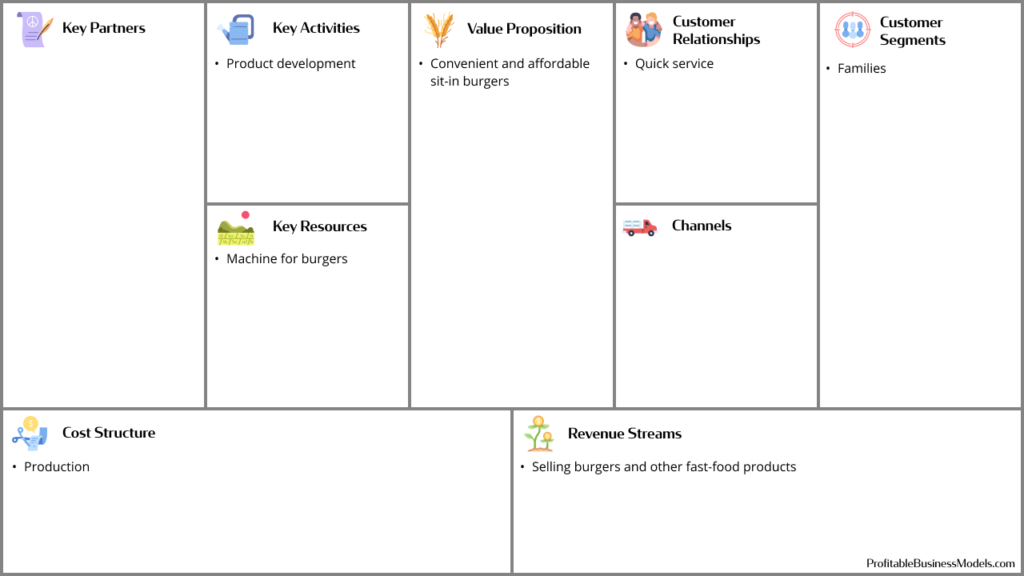
Insta-Burger King’s Business Model Canvas: The Early Days after Franchising
At this point, Insta-Burger King’s Business Model Canvas looked like this:
Value Proposition
- Convenient and affordable sit-in burgers
- A turn key business for franchisees
Customer Segments
- Families
- Franchisees
Customer Relationships
- Quick service
Channels
- TV and print media commercials
- Billboard signs
Revenue streams
- Selling burgers and other fast-food products
Key activities
- Product development (the Whopper)
- R&D (constructing new burger machine)
- Launching new restaurants in Florida
Key resources
- Machine for burgers
Key partners
- Investors (mainly franchisees)
Cost structures
- Location expansion
- Production
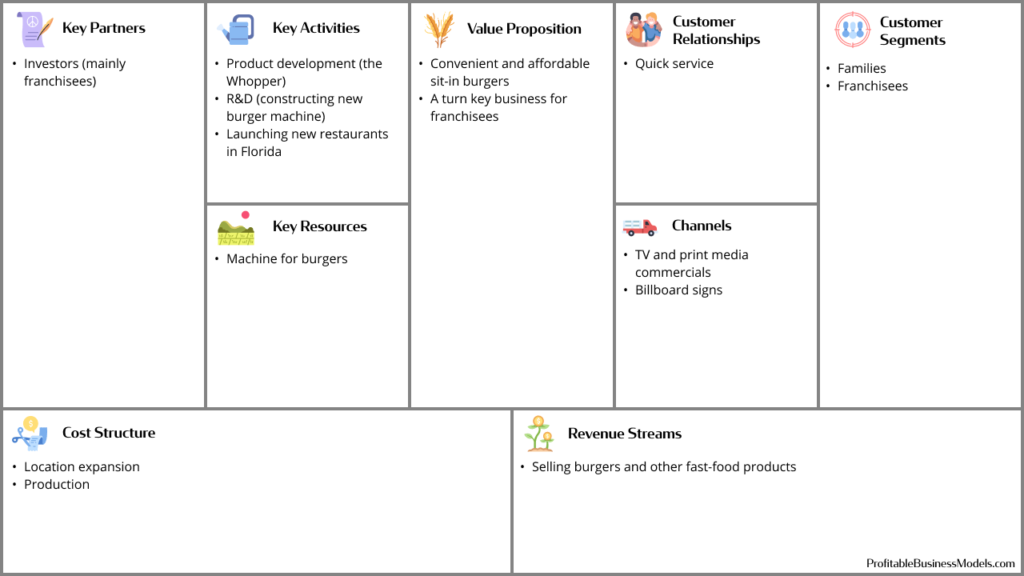
1960-1969: The Whopping 60’s
1967: Restructuring and McLamore and Edgerton Sell Burger King
Burger King Corporation expanded rapidly, and by 1967 the restaurant chain had more than 400 locations in at least 20 states in the United States and a few in countries like Puerto Rico. McLamore and Edgerton had completely restructured the company, opening a separate subsidiary called Distron to manage distribution and supply chain issues.
Distron primarily served the company-owned stores and approximately 50 to 60% of franchised stores. Under the franchise agreements, the Burger King franchisees were free to purchase supplies from one of seventeen independent distribution systems.
But there was an issue, while the franchising system set up by McLamore and Edgerton allowed the franchise to expand rapidly, it lacked proper contractual restraints and controls.
The franchisee system had so many inconsistencies, which led to low product quality and inconsistent products. This damaged the reputation of the chain, and they lagged behind McDonald’s in sales and profitability.
Another issue was with the franchise agreements themselves. McLamore and Edgerton had attracted investors by selling exclusive land rights to large territories throughout the country. The buyers of these land rights, many of them large businesses themselves, had the right to do as they pleased with their purchased territory.
In exchange, McLamore and Edgerton took their initial payments (which varied with the territory) and 1 % of the total sales. These franchise agreements gave the parent company very little power to prevent the franchises from operating their restaurants the way they wanted. The franchises could buy land, build as many stores as they liked, sell part of the territory to other investors, or diversify.
Moreover, there was a leadership issue. Edgerton was a restaurateur through and through and was in charge of the daily operations. McLamore, on the other hand, was beginning to focus more on spending his time at the golf course. He wanted to indulge his passions as he had no real need to keep working being married to a woman of wealth.
Selling Burger King Corp & Restructuring
McLamore and Edgerton decided to sell Burger King to Pillsbury Corporation. At this time, Burger King was worth an estimated US$18 million and had over 8,000 employees. The former partners shared the $20 million in proceeds from the sale.
Pillsbury Corp inherited the franchise issues and set out to correct them. One of the most challenging issues with the business at the time was that some of the company’s large investors expanded at a rate rivaling that of the parent company.
Additionally, the loosely knit franchising system failed to provide a consistent company image. McLamore and Edgerton did not have proper measures to check on their franchises and only used a small field staff for franchise support. This was a significant flaw in a chain aiming to attract customers by assuring them what to expect in every Burger King.
1970-1979: Franchise Wars
1970-1977: The Not So Golden 70’s; Trouble from Within
Pillsbury set out to crack down on franchise owners; unfortunately, some large franchisees thought they could run their Burger King outlets better than the parent company. Wealthy Louisianans Billy and Jimmy Trotter, who had bought their first Burger King restaurant in 1963, were particularly convinced of this notion.
By 1970 the Trotters controlled almost two dozen Burger King restaurants. They decided to go public under the name Self Service Restaurants Inc. That same year when the franchisees in control of the lucrative Chicago market decided to sell out, Billy Trotter flew to Chicago in a snowstorm to purchase the territory for $8 million. By the time Pillsbury executives arrived in Chicago the next day, they had found they had been bested by their own franchisee.
The Trotters were not done. By the end of 1971, they owned 351 stores and made at least $ 32 million in sales. The brothers bought out two steakhouse chains, renaming their company Chart House after one of the steakhouse chains. The Trotter brothers established their own inspection and training programs and decided on their own food suppliers.
As 1972 rolled by, the brothers were ready to take over altogether. Feeling confident, the Trotters made Pillsbury Corp an offer for $100 million for Burger King. Pillsbury refused, and the Trotters suggested that both Pillsbury and Chart House separate the two Burger King holdings into separate companies.
When Pillsbury refused to surrender Burger King to the Trotters, the brothers went on the assault. They continued to acquire Burger King territories piece by piece. They bought nine stores in Boston and thirteen in Houston.
Sensing the danger they were in thanks to the lousy franchise agreements, Pillsbury sued the Boston franchisees who had sold to Chart House. They cited Pillsbury’s contractual right of first refusal to any sale. Thankfully Chart House compromised, agreeing to give up its Boston holdings in exchange for keeping its Houston properties.
1978-1979: Operation Phoenix
It was clear, the ship was sinking, and something needed to be done as soon as possible. In a move some would call unethical, Burger King poached McDonald’s executive Donald N. Smith to help revamp the company.
Smith came in and launched Operation Phoenix, focusing his attention on restructuring the corporate business practices at all levels of the company. He set out making several changes which included:
- Updating the franchise agreements
Smith “McDonaldized” the company’s franchise agreements by centralizing control, a process that was especially felt among the franchise holders.
While Burger King had grown by selling wide territorial rights, McDonald’s had chosen to lease stores to franchisees. This allowed McDonald’s to keep the land rights and demand a high degree of uniformity in return.
At this point, Burger King owned only 34% of the land and buildings in which its products were sold. Smith knew that land ownership would be advantageous as an appreciating asset and a source of tax deductions. More importantly, it would give Burger King Corp a landlord’s power over rebellious franchisees.
The new franchise contracts were awarded to individuals and not partnerships or companies. The terms stipulated that franchisees were not allowed to own other restaurants and had to live within an hour’s drive of their franchise. This effectively stopped franchisees from getting too big.
The new franchise agreement brought the company’s share of outlet ownership up to 42%. Lastly, Smith created ten regional offices to manage franchises.
- Broadening of the menu
Smith turned his attention to the Burger King menu as well. First, he introduced the more popular french fry technique that McDonald’s was using. Next, in 1978 in response to the appeal that the newcomer Wendy’s had for adult customers, Smith added specialty sandwiches such as chicken, fish, ham and cheese, and steak to the menu.
This new line of sandwiches was one of the first attempts by Burger King to target a specific demographic. They believed that people aged 18 to 34 would be willing to spend more on a higher quality product. The strategy worked, and Burger King experienced company sales by 15%.
The next radical expansion of the menu was the introduction of Burger King breakfast in 1979. McDonald’s had shown that breakfast could be a profitable fast-food model. Having a breakfast menu spread fixed costs over long hours of operation.
Unfortunately, Burger King had a problem with launching its breakfast menu. The flame broilers could not be adapted as quickly to breakfast entrees as McDonald’s grills could. Instead of spending money on buying new grills, Smith tasked the food research and development team to develop breakfast entrees that could be prepared on existing equipment. However, they would only get it right a few years later.
- Standardizing the company brand
The last significant change that Smith initiated was the standardization of the Burger King Corp brand. Smith mandated a yearly two-day check of each franchise and frequent unscheduled visits to tackle the inconsistency problem. He also ordered new store designs that ensured every franchise bearing the Burger King name would look identical.
Burger King Business Model Canvas: The Franchisee War Days
At this point, Burger King’s Business Model Canvas looked like this:
Value Proposition
- Convenient and affordable sit-in fast food
- Broad menu offerings
Customer Segments
- Families
- Adults
- Young adults (ages 18- 34)
Customer Relationships
- Quick service and payment in advance
Channels
- TV and print media commercials
- Billboard signs
Revenue streams
- Selling burgers and other fast-food products
Key activities
- Solving the franchise mess
- Launching new restaurants around the United States
- Broadening product offerings (new menu options)
Key resources
- Distron (Burger King own’s distribution and supply division)
- Land for lease
Key partners
- Investors (mainly franchisees)
Cost structures
- Local and International expansion
- Production
- Acquisition of land for lease
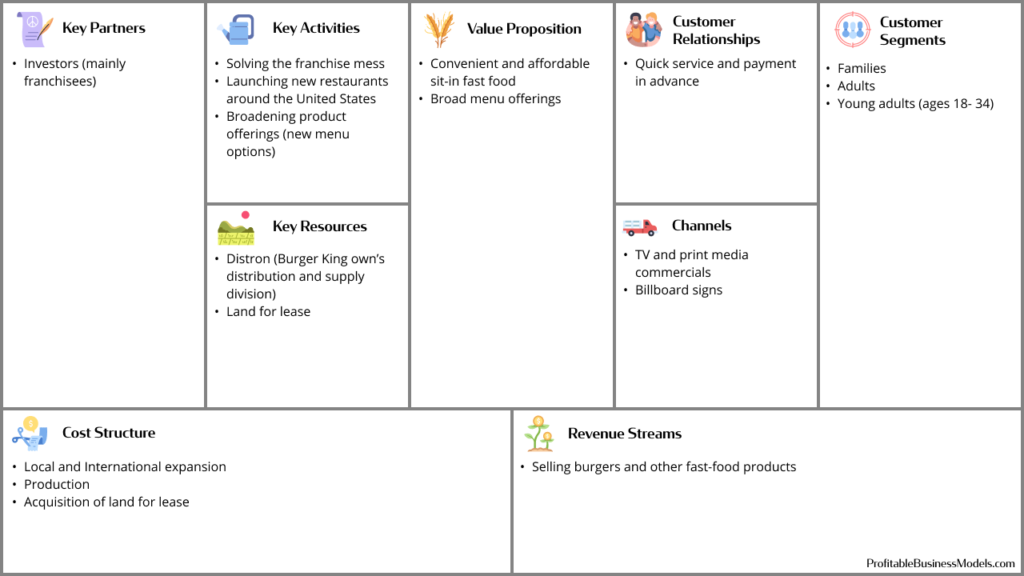
1980-1989: A Decade of Decline & the Burger Wars
In 1980, Smith left Burger King for soft drinks producer PepsiCo and then moved on to Pizza Hut. Meanwhile, for the first few years after Smith’s departure, Burger King’s management followed the measures he had put in place. This helped the company to reach the number-two position within two years.
1982: Aggressive Ad Campaign: The Burger Wars
Pillsbury tasked the executive vice president of restaurant operations, Norman E. Brinker, to turn the brand around and strengthen its position against McDonald’s. His first action plan was to initiate an advertising campaign that emphasized claims of Burger King’s flame-broiled burgers superiority over its rival’s.
Burger King launched a nationwide TV advert attacking McDonald’s. The ad was controversial, and McDonald’s sued Burger King and their ad agency J. Walter Thompson. They settled the following year. Despite the controversy, the ad boosted sales.
Frequent Change in Leadership
However, frequent changes at the management level for the next few years resulted in inconsistent management. Louis P. Neeb took over after Smith, Need was followed less than two years later by Jerry Ruenheck.
Ruenheck resigned to become a Burger King franchise owner in Florida less than two years later. His successor, Jay Darling, resigned a year later to operate a Burger King franchise himself. Finally, Charles Olcott, a conservative former chief financial officer, took over in 1987.
Growth and Expansion despite Leadership Challenges
Fortunately, the company managed to withstand the constant change in leadership and continued to expand abroad. The company opened a training center in London to cater to its European franchisees and employees in 1985.
The work that Smith had started on the Burger King breakfast menu finally paid off. In 1983, Burger King launched the highly successful Croissan’wich. French toast sticks were added to the menu in 1985, which increased the company’s competitive advantage in the breakfast market dominated by McDonald’s.
Aside from successful breakfast entries, Burger King added salad bars and a “light” menu to cater for the growth of the healthier, less fat movement. Unfortunately, the salad bar had moderate success. The franchisees complained about the high operating costs and a poor return on investment.
The pita salad option was quickly dropped from the salad bar, as were plans to use the bar unit to boost breakfast sales. In 1987 Burger King switched out its salad bar with a test line of prepackaged salads that included chef and garden salads. This was a hit, and the salad bar was eventually eliminated in favor of packaged salads.
Additionally, in 1985, the company began a $100 million program to remodel most of its restaurants. The remodel was a response to calls against the use of plastic. Burger King decided to include more natural materials, such as wood and plants, in their restaurants.
Lastly, the company embraced technology and completely computerized its cooking and cash register operations, ensuring that even the least skilled workers could do the job. By the end of 1985, average sales per restaurant reached the $1 million mark. The company was clearly doing well, but trouble was brewing.
1986: Inconsistency Rears Its Ugly Head Again
As the late 80’s rolled by, constant change in management meant that more and more of Smith’s measures were ignored. By 1986, Burger King was again battling complaints that its service and food were inconsistent.
The identity crisis played itself in public. The company changed ad styles with almost the same frequency that it changed managers. Their customers could not be sure what they would get from the different franchises. With McDonald’s providing the consistency that Burger King was missing, the company began to see a system-wide decline in sales.
To try and counteract this problem, Burger King introduced Chicken Tenders in 1986. The product was a hit, so much so that they could not obtain enough chicken to meet demand. Burger King was forced to withdraw its $30 million introductory ad campaign, further plunging the corporation into a financial decline.
While these efforts were initially effective, Pillsbury eventually discarded many of the changes implemented by Smith. This resulted in Burger King falling into a revenue slump that damaged both Burger King and Pillsbury’s finances.
Ineffective leadership and poor operating performance continued to plague Burger King throughout the 80s until Pillsbury suffered a hostile takeover from the British entertainment conglomerate Grand Metropolitan in 1989. While Burger King was riddled with several problems, the company was still viable and had a solid presence in the fast-food industry with 5,500 restaurants in 50 states and 30 foreign countries.
Burger King Business Model Canvas: The Burger Wars Days
At this point, Burger King’s Business Model Canvas looked like this:
Value Proposition
- Convenient and affordable sit-in fast food
- Broad menu offerings
Customer Segments
- Families
- Adults
Customer Relationships
Channels
- TV and print media commercials
- Billboard signs
Revenue streams
- Selling burgers and other fast-food products
- Land for lease
Key activities
- Aggressive ad campaigns
- Developing a successful breakfast menu
- Remodeling of restaurants
Key resources
Key partners
- Investors (mainly franchisees)
Cost structures
- Restaurant remodeling
- Marketing
- Product development
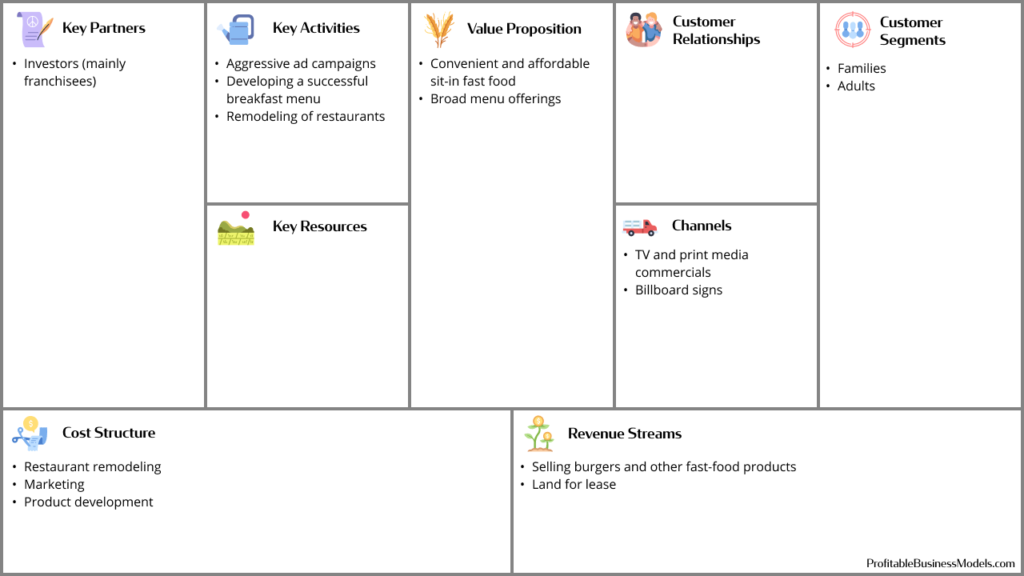
Conclusion
While the end of the 80s signaled a sad decline for the company, Burger King showed that it could turn a simple idea into a profitable business model. Despite leadership and corporate structure challenges, the fast-food chain managed to get through some of its tough times with minimal damage.
Sources
- https://expandedramblings.com/index.php/burger-king-statistics-facts/
- https://www.nytimes.com/2018/04/16/obituaries/david-edgerton-90-dies-helped-start-burger-king-in-the-60s.html
- https://gunthertoodys.com/fast-food-restaurants-born-1950s/
- https://www.referenceforbusiness.com/history2/13/Burger-King-Corporation.html
- https://en.wikipedia.org/wiki/Burger_King
- https://en.wikipedia.org/wiki/Burger_King_products
- https://gunthertoodys.com/fast-food-restaurants-born-1950s/
- https://www.britannica.com/topic/Burger-King-Corporation
- https://www.wikiwand.com/en/History_of_Burger_King
- https://www.thebalancesmb.com/history-of-burger-king-1350968
